
Executive Summary: Driving growth is critical for brands and businesses. While organizations like McDonald’s follow a disciplined growth strategy framework around key pillars, others are more opportunistic. External events like COVID and tariffs can disrupt plans and require updates and pivots. This article provides a clear guide for growth strategy planning, complete with examples.
2 Focused Approaches from Yeti and McDonald’s (Plus 1 Random “Strategy”)
What’s your brand’s starting point for its growth strategy framework? Are you following a focused strategy like McDonald’s and Yeti? Or is your approach ad hoc and random? In recent months, we’ve had conversations with both kinds of leaders. Let’s check in on how growth strategy framework approaches are working out.
- Mcdonald’s focused growth strategy: Three core pillars are at the heart of McDonald’s Accelerating the Arches Strategic Plan: Maximize our Marketing (brand, affordability ), Commit to the Core (burger, chicken, coffee) and Double Down on the 4D’s (Digital, Delivery, Drive Thru and Development). The growth pillars whose first initials spell out M-C-D are part of the 2020 strategy refresh in December 2023.
- Yeti’s focused growth strategy: Reach new customers with new distribution channels and expand into new product categories. Yeti doesn’t have a published polished strategic plan like McDonald’s, but it does have several major strategies in its published documents: (1) Supply chain diversification away from China. (2) Continued new product and category expansion, though with slower progress in the US because of tariffs (80% of sales are in US): As one source explains, “Yeti will launch 30 new products in 2025 compared to 24 in 2024, but some will have limited supply and others will launch exclusively outside of the U.S. Those launches will include insulated sports jugs, additional backpack releases, thermal lunch bags and boxes, Yeti’s first beach chair, and an extension in the brand’s Go Box protective case family.”
- Random growth strategy: Develop specific product applications for customers in multiple markets to prove viability, learn fast and move on (a.k.a., throw a bunch of stuff at the wall and see what sticks). The opportunistic approach can lead to significant growth, as Insight to Action is currently working with a $900 million startup food company that has followed a customer-driven model across multiple markets to grow. One note is that strong financial discipline is important to follow this strategy.
What if Leaders Aren’t Focused on a Growth Strategy Framework?
Other leaders aren’t focused on growth. They are occupied with working “in the business” to triage talent shortfalls, adapt to supply chain disruption, work effectively with a remote and/or hybrid team, navigate supplier cost volatility and/or manage their own price increases. These individuals are not making the time to step back and work “on the business” to develop a forward-looking growth strategy framework.
Overall, the impression we’ve gained is that many organizations are lagging or behind on updating their growth strategy, or perhaps lack a growth strategy altogether. During the years since COVID, many businesses are finding that their traditional growth strategies aren’t working. Their leaders feel too preoccupied to invest time in planning and working together with their leadership team to develop a shared situational awareness. If wartime Ukrainian military commanders can invest the time to create a new drone-focused military branch (Unmanned Systems Forces) and operationalize tight plan-adapt-learn loops, these excuses for a lack of strategy and strategic planning by business leaders fall flat, in my opinion.
Starting Growth Strategy Framework Development: the Role of the Core Team
A typical brand’s growth strategy framework development process will start with the creation of a growth strategy core team. This core growth strategy team has a number of responsibilities, such as:
- aligning organization and stakeholders on the timeline and goals
- outlining the steps needed to develop the growth strategy
- recruiting the needed resources (including internal and external resources like consultants)
- managing the timeline and communication to stakeholders, including board presentations
The core growth strategy team does much of the “heavy lifting” to prepare for growth strategy work sessions and make the time spent working together on the growth strategy as productive as possible.
Starting Growth Strategy Framework Development: Situation Assessment Fact Base
At Insight to Action, we’re big believers in having core and extended team members create a robust situation analysis and market outlook prior to coming to the meeting. Along with the situation assessment, each participant will be asked to articulate growth hypotheses.
A recent situation assessment outline included the following components. The first nine are the focus of the situation assessment, while the last five are output of the growth strategy framework that are developed and refined in the worksessions.
- External assessment key findings: US market size, US market growth, key segments
- External assessment: drivers of demand (what are the factors that are driving demand?)
- External assessment: channels (size, growth)
- External assessment: competitors (financial and unit results, capacity, cost/lb., product and pricing, customers and sales, SWOT)
- External assessment: 4 P’s summary (product, place, promotion, pricing)
- External assessment: 5 C’s summary (category, consumers, customers, channels, competition)
- Internal assessment: company results: $, units, CAGR, P&L
- Internal assessment: capabilities
- Internal assessment: SWOT (strengths, weaknesses, opportunities and threats)
- Vision including BHAG, values, customer, product
- Financial objectives 2021-2026
- Most important strategies
- Strategy detail pages
- Summary on a page
Often, the core growth strategy team will work with line executives to refine this situation assessment. We’ll work with the team to agree on a starting template to use for the situation assessment.
What Is an Example of a Growth Strategy Framework?
A 2025 example includes six key areas for External Assessment. The six are:
- Macro Food Consumer Trends, including consumer, product, packaging
- PESTEL analysis, Political, Environmental, Social, Technological, Economic and Legal
- Product Category, including size and growth, product purchasing trends, demand drivers, pricing tier dynamics, role of private label
- Retailers, including trends, growth and commitment to category, current retailers to grow with, new retailers
- Regions with regional product preferences and growth opportunities
- Competitive Landscape, including five factors analysis, growth share matrix, key competitor “deep dive”
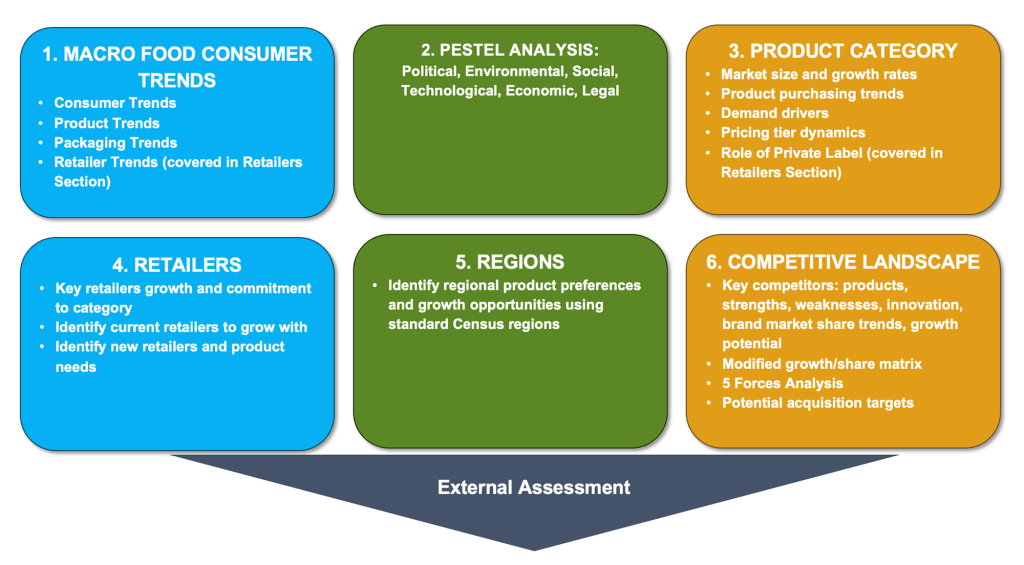
Should Companies Conduct an Internal Assessment, Too?
Yes, this step can be critical for growth. The Internal Assessment also covers six areas. They are:
- Company Position by Retailer
- Company Position by Product, with a focus on identifying existing and new core products
- Consumer Overview, including target, equity pyramid and value proposition
- SWOT assessment (strengths, weaknesses, opportunities and threats)
- Manufacturing Overview
- Management Interests
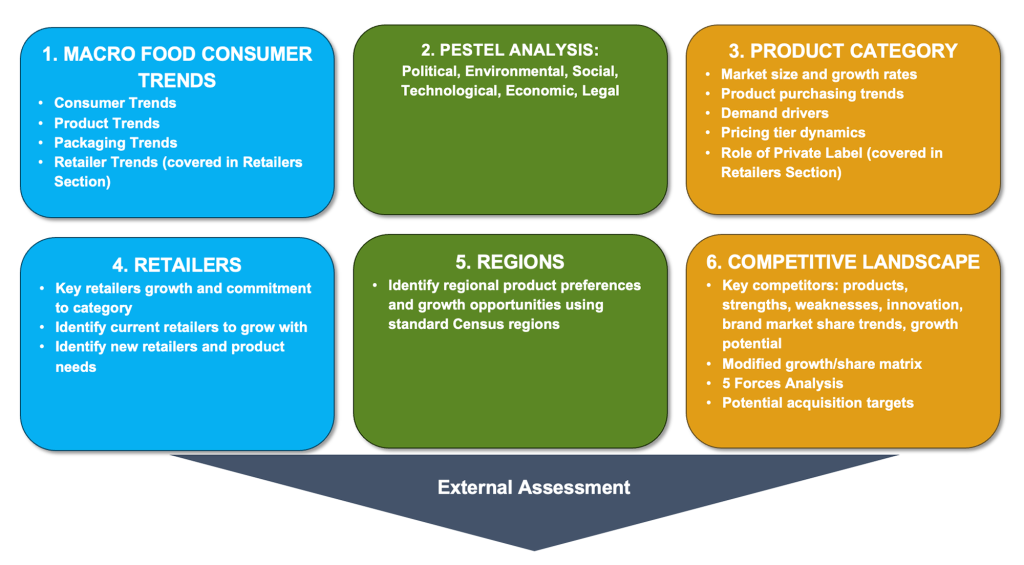
Starting Growth Strategy Framework Development: Offsite Growth Strategy Summit Worksessions
Once the fact base is developed, it’s typical to hold an offsite summit with the organizational cross-functional team to focus on the integration and trade-offs that are required for a disciplined growth strategy. This summit is typically one to three days in length.
We recommend having a professional facilitator moderate the meetings with the team to allow all to participate. The objective should be to develop a starting growth strategy framework.
Key Components of the Growth Strategy Summit
- Situation assessment sharing: Each line of business to share their situation assessment and summary. The purpose is to get all the participants on the same page with regards to the external market and internal situation. If there are areas of question or gaps, those should be highlighted and moved to a “parking lot” list, so they do not derail the meeting. This could be done in the afternoon before the start of the strategy development session.
- Brain walking on the key strategies and related initiatives: Brain walking requires all participants to get up and out of their seats and actively participate and collaborate. We recommend using flip chart paper and physically moving around rather than sitting and passing paper around. This is a highly-productive exercise and ideally is done at the beginning of the day.
- Vision exercise in pairs or triads: While some are able to work well independently, many executives work better in pairs or triads with others to bounce ideas off of. Each pair or triad will take some time to develop the starting vision, and then share with the group.
- Selection of the starting most relevant vision, strategies, and initiatives: Dot voting can be used, or typed notes with a number for each idea can be distributed for the team to select from. Before the group breaks up, it’s helpful to recap the summary. The expectation is for further vetting and changes after the meeting.
Growth Strategy Summit Output Examples
After further refinement, the end output can be summarized in a one-page growth strategy framework shown below. This powerful growth strategy framework was developed by Peter Klein, CEO of PK Associates.

McDonald’s “Accelerating the Arches” provides another example, this time on two pages.
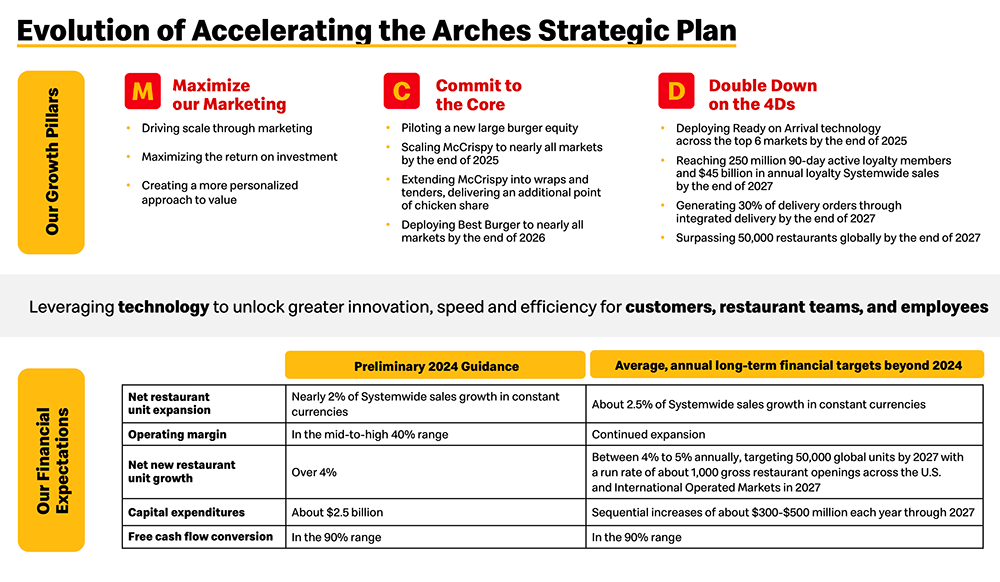
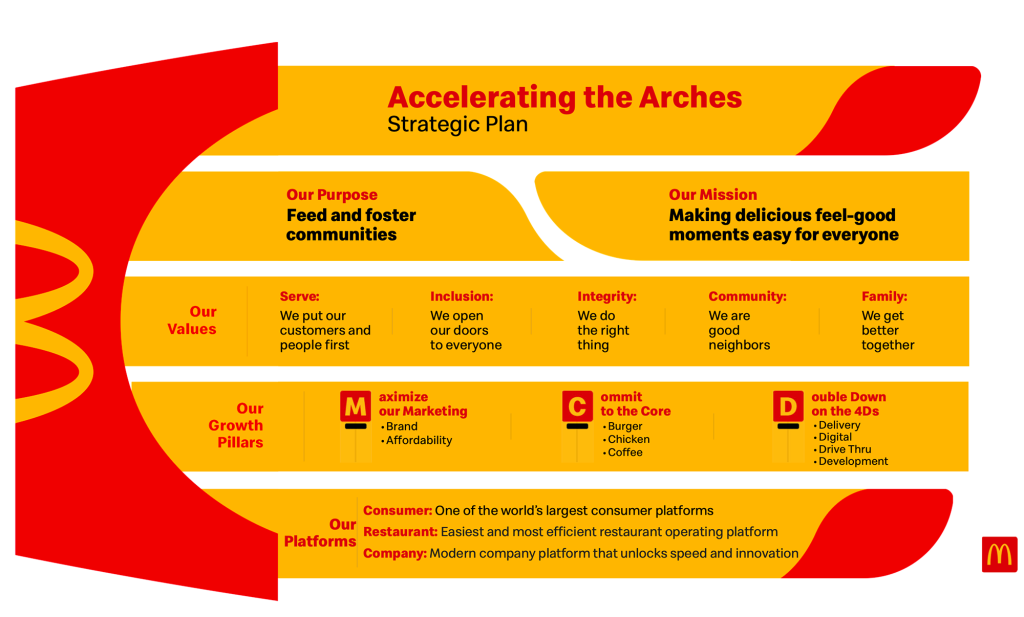
Starting Growth Strategy Framework Development: Scheduling the Growth Strategy Worksessions
Since COVID, it’s been difficult for many organizations to schedule growth strategy meetings with their cross-functional leadership teams.
There are many reasons for this, but one basic reason is that the larger team needed for the growth strategy worksessions may not be back at work regularly and/or able to set aside time to meet offsite.
Gallup finds that since 2022, hybrid roles have “taken hold” and account for 51% of remote-capable employees, compared with 28% exclusively remote and 21% on-site. Hybrid employees spend about 46% of their time (or 2.3 days per week) in the office in 2025, up slightly from 42% in 2024.
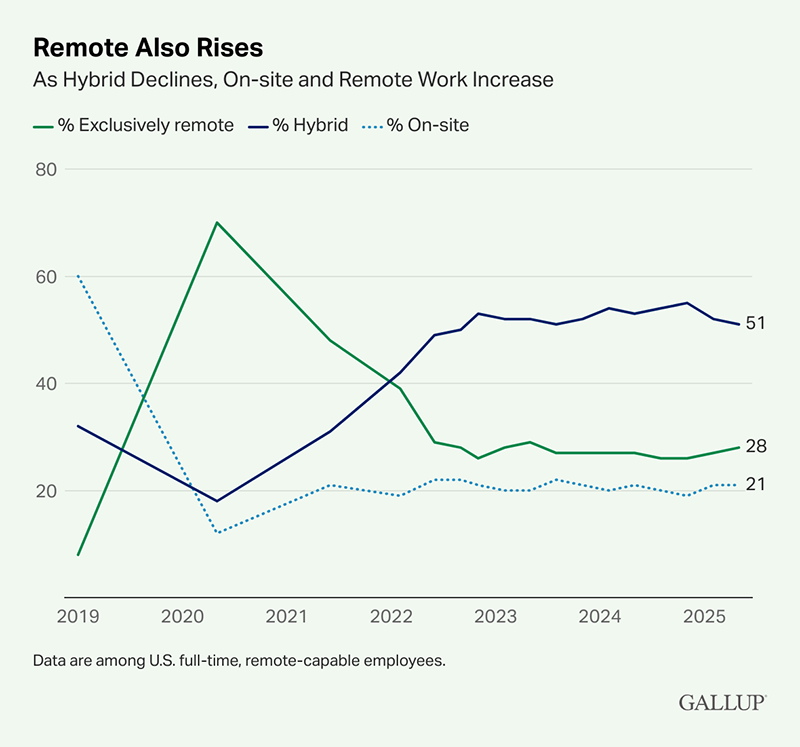
With many employers requiring increased in-office presence, the in-office days are jam packed with meetings. One company that took a more creative approach to this is Smuckers, with its 22 core weeks per year.
We’ve come across several examples of organizations that wanted to hold growth strategy worksessions, but had to reschedule, defer, or even cancel. These include:
- A California-based food company who initially attempted to schedule its growth strategy offsite with 12 participants in May 2021 and ultimately rescheduled to 2023.
- In September 2025, we needed to consolidate four separate days of worksessions into two long days due to other urgent priorities.
If your brand has completed a growth strategy framework in the past year, we’d love to learn about how you overcame the challenges around focus and prioritization, along with logistics.
More case studies (e.g., Celsius, Glossier Black Cherry, Vacation Destinations, Skechers Hands Free Slip ins and Dawn Platinum Plus Powerwash) and resources on growth strategy are available at the resources page. Or contact us to start a collaboration today.

